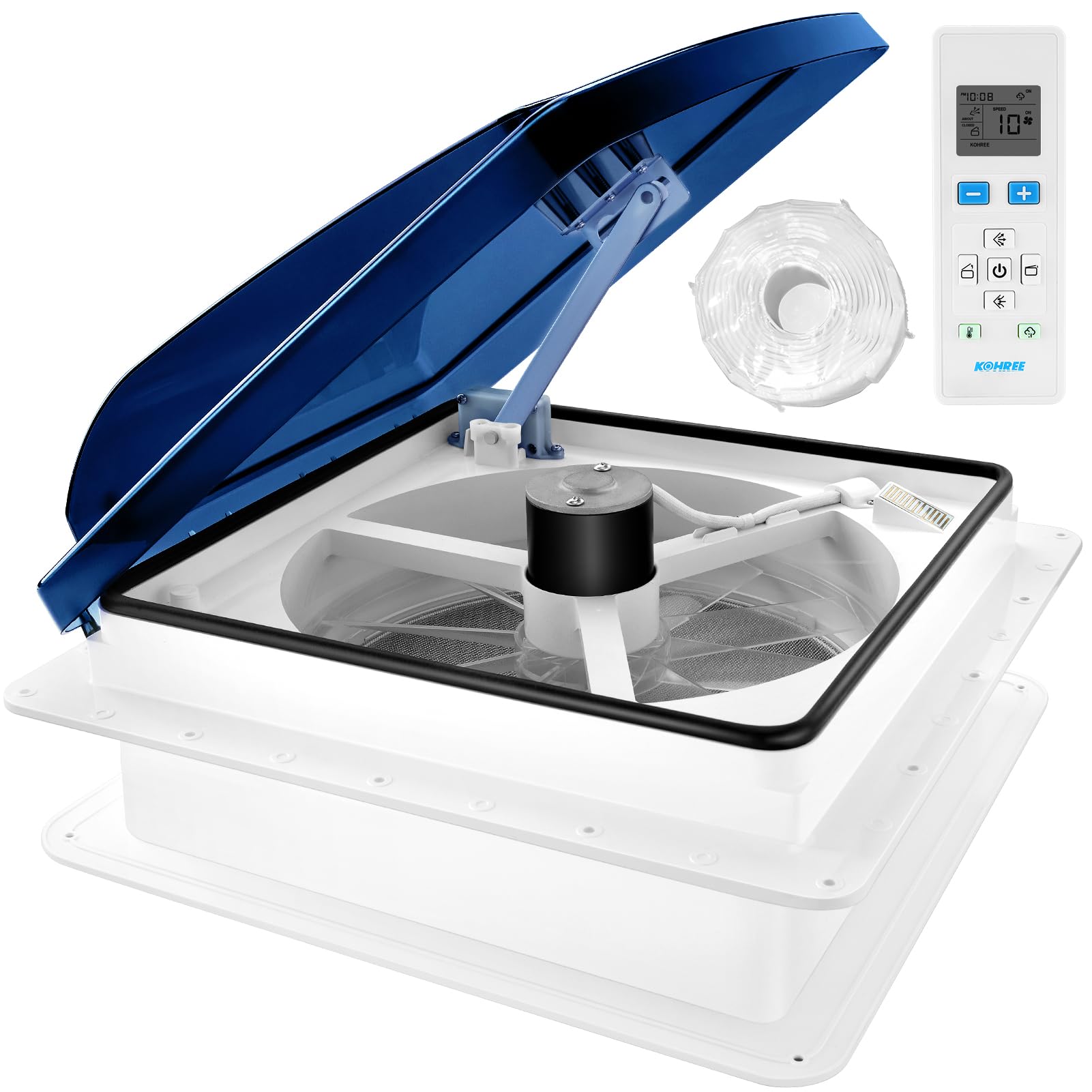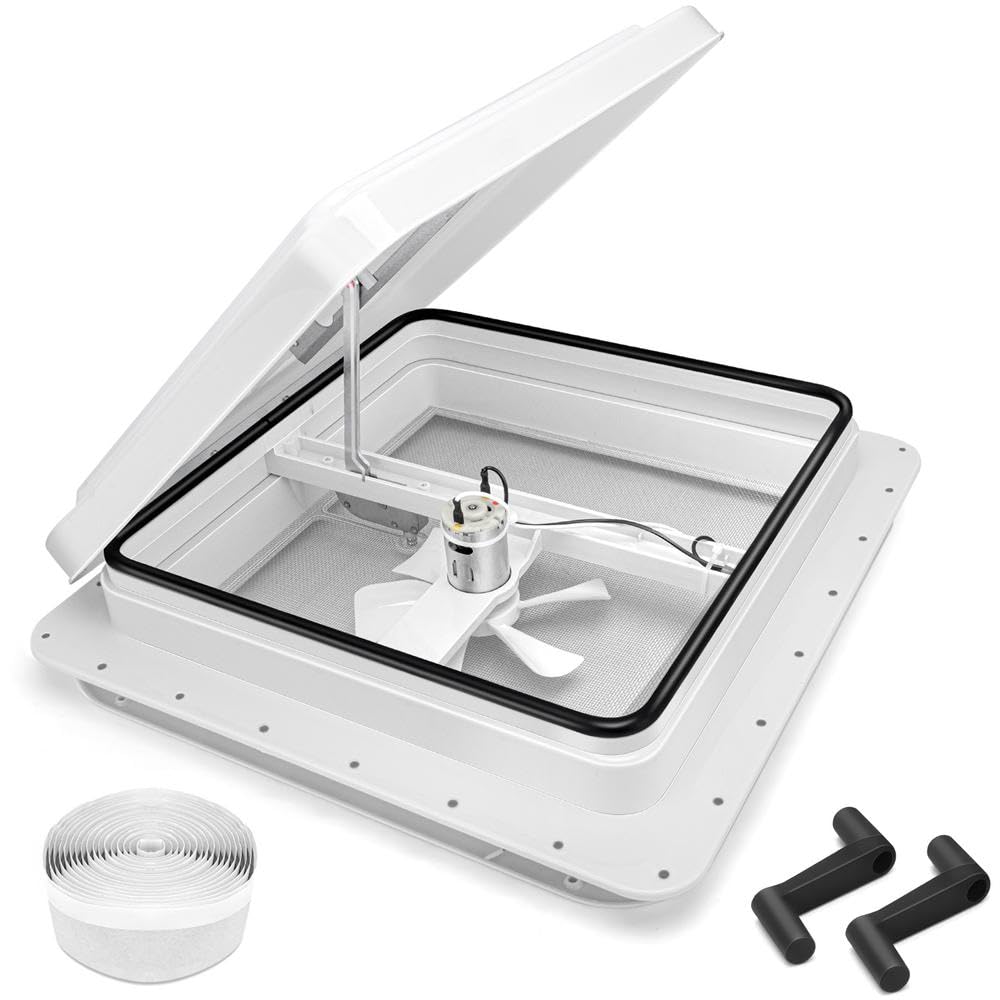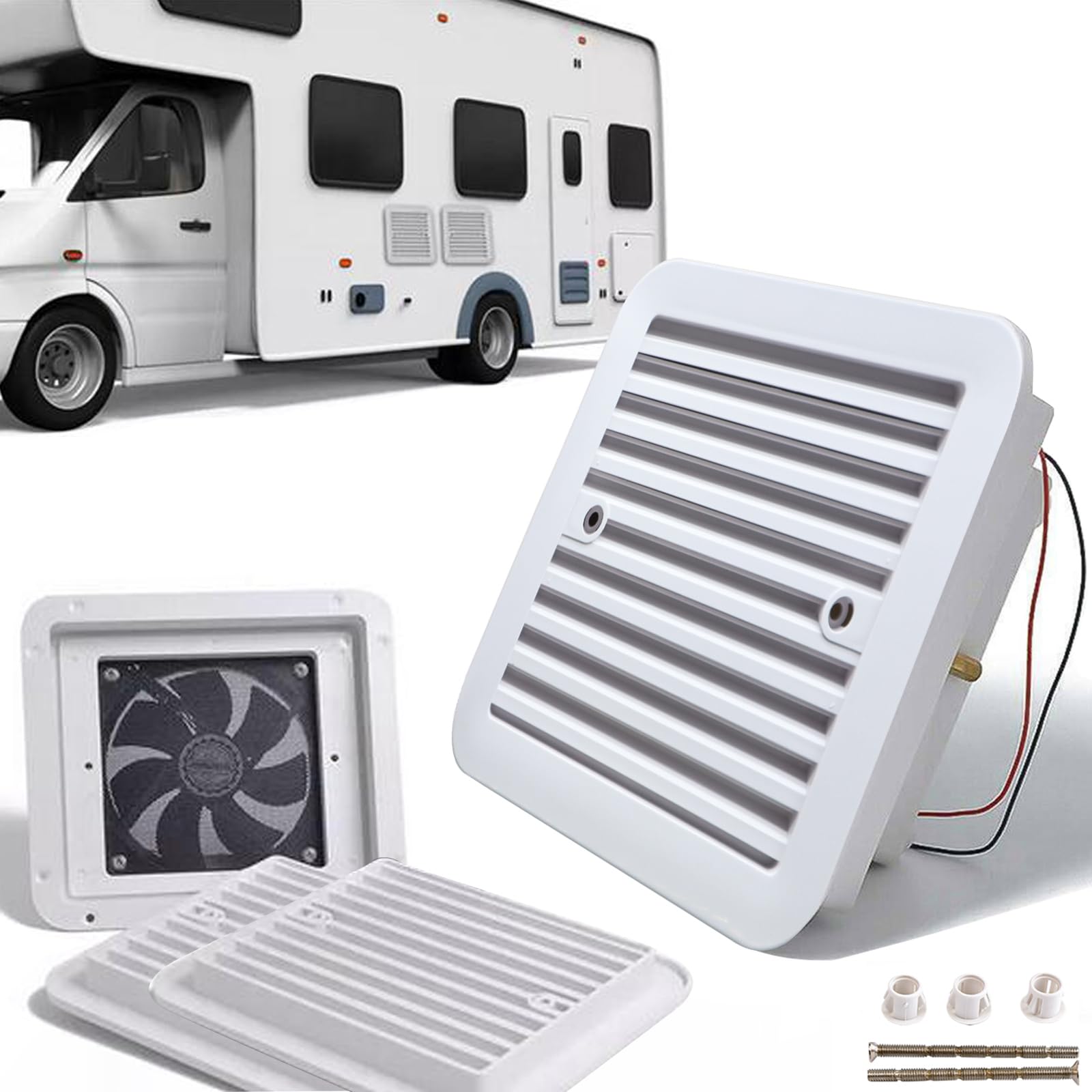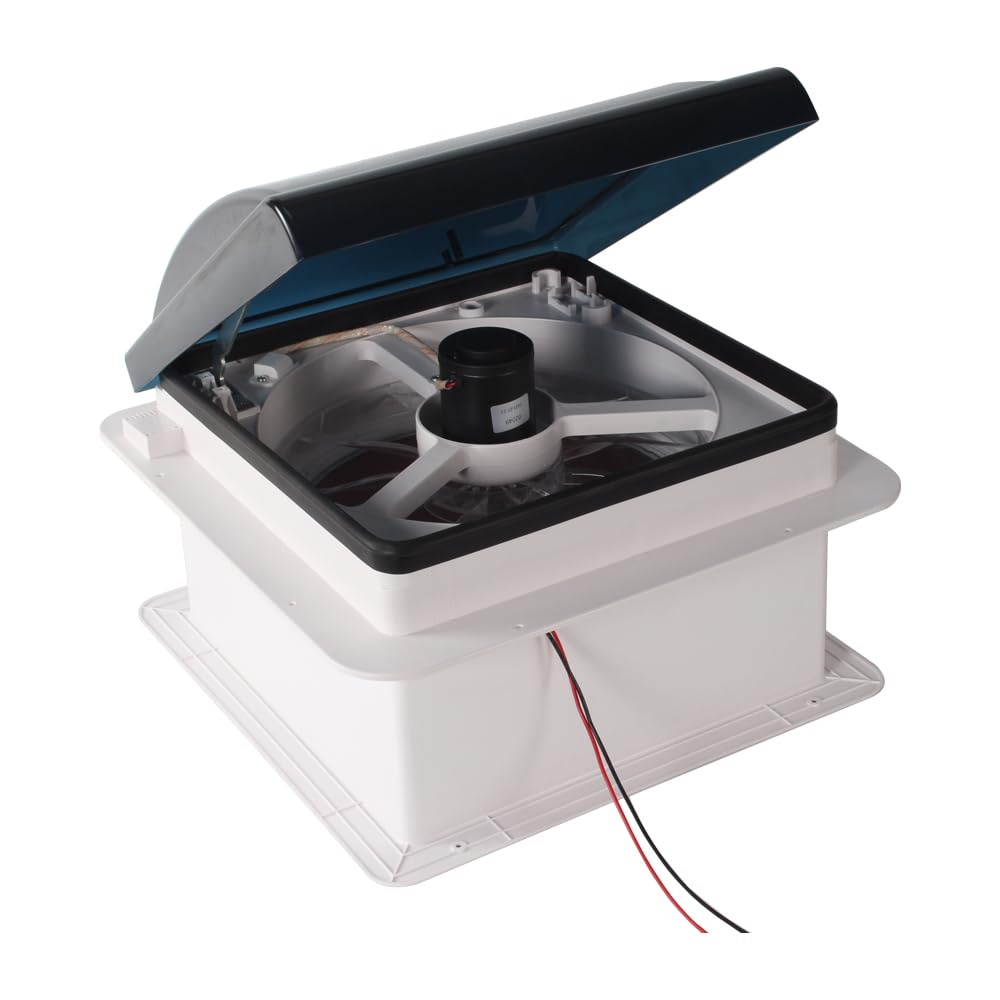
10 Must-Know RV Ventilation Hacks for a Comfortable Trip
Good RV Ventilation makes the difference between a stuffy, sweaty trip and a comfortable, healthy one. In this guide you’ll learn practical hacks that save energy, reduce condensation, cut odors and keep your air moving efficiently in a small space. Each tip is aimed at helping you spend less time troubleshooting and more time enjoying the road.
You’ll get quick fixes, product recommendations and simple installs so you can improve airflow whether you’re boondocking, sleeping overnight or running the AC.
Table of Contents
Top Picks
|
Category |
Product |
Price |
Score |
|---|---|---|---|
|
🏆 Best Overall |
RV Vent Fan Roof 12V Remote Control 14 x 14 inches 10-Speed (RVLOVENT) |
$129.90 |
92/100 |
|
💰 Best Value |
HENG’S INDUSTRIES 14″ Universal Roof Vent, White Lid (Part 71111A-C1G1) |
$39.99 |
88/100 |
|
⚡ Best Performance |
Kohree 14″ RV Vent Fan 10 Speed Reversible with Remote Control |
$140.99 |
90/100 |
|
🎯 Best for Beginners |
14″ RV Roof Vent for Camper Trailer Universal White Lid with 12V Fan (caqeg) |
$59.99 |
87/100 |
|
🔊 Best Sound Quality |
$129.00 |
84/100 |
How We Picked These RV Ventilation Solutions
You want solutions that actually improve airflow without creating new headaches. We focused on: airflow and effectiveness (CFM or stated airflow), noise (lower dB = better night sleep), power draw (important when you’re on battery), key features (remote control, rain/temperature sensors, reversible intake/exhaust), fit and ease of installation (14″ standard openings, universal fit), durability and weatherproofing, and value for money.
We also considered real-user feedback so you get options that perform in the field, not just on paper.
Heng’s 14″ Universal Roof Vent (White)
You want reliable airflow in your rig, and this Heng’s 14″ universal roof vent is the simple replacement that gets you there. It fits common cutouts (estimated 14-1/2″ x 14-1/2″) and is designed to swap in for Elixer or Ventline vents, so you don’t have to rebuild the roof opening.
For everyday use it keeps air moving while you cook, sleep, or dry damp gear; on longer or off-grid trips it helps with passive RV Ventilation so you’re not running the AC all the time. It’s lightweight, comes with the garnish/interior trim ring, and the white lid blends with most interiors.
If you want a straightforward, cost-effective fix for stale air or a failing OEM vent, this is an easy swap that I’d recommend for most campers.
What People Say
People report it fits like the original and works reliably as a direct replacement, so you can expect straightforward performance without a lot of fuss.
🗣️ L Roy
This was a replacement for the original one — it fit just right.
🗣️ Dean Harder
Install on customers camper and seems to be well made.
Long-Term Cost Benefits
Better ventilation cuts down on how long you run climate systems, lowers moisture-related repair risk, and extends the life of interior finishes—small savings add up over several seasons.
Return on Investment
At $39.99, swapping a failing vent is cheaper than repairing water or mold damage later; you often recoup the cost after one season of reduced AC use or avoided repairs.
Situational Benefits
|
Situation |
How It Helps |
|---|---|
|
Hot Summer Camping |
Boosts airflow to remove hot pockets and reduce AC runtime while you sleep or relax. |
|
Rainy Weather |
A solid lid and proper installation help ventilate without letting water into the cabin when closed. |
|
Replacing Old OEM Vents |
Matches common cut-out sizes so you can swap it in without major roof modifications. |
|
Boondocking/Off-Grid |
Improves passive ventilation so you can rely less on battery-draining fans or AC. |
Environmental Benefits
|
Impact |
Benefit |
|---|---|
|
Lower Energy Use |
Better airflow reduces time spent running air conditioning, cutting fuel or electrical demand. |
|
Less Moisture Damage |
Improved ventilation reduces mold and rot risk, meaning fewer replacement materials over time. |
|
Durable Replacement |
A long-lasting vent means fewer disposals and less waste compared with repeated disposable fixes. |
Emotional Benefits
You’ll feel more comfortable and less anxious about stuffy air or lingering damp smells, especially when sharing a small space with family or friends.
Ease of Use
|
Feature |
Ease Level |
|---|---|
|
Installation |
Moderate |
|
Maintenance |
Easy |
|
Compatibility |
Easy |
|
Operation |
Easy |
Versatility
Works on campers, travel vans, trailers and many RV roof openings; available in white or smoke and in multiple pack sizes if you need more than one.
Energy Efficiency
By improving passive airflow and letting you ventilate without always running the AC, it helps lower energy consumption during trips.
Key Benefits
- Universal fit replaces common Elixer and Ventline vents
- Includes garnish/interior trim ring for a clean finish
- Lightweight and designed for rooftop use on campers and trailers
- Helps improve RV Ventilation and reduce reliance on air conditioning
- Reasonably priced replacement that’s easy to source
Current Price: $39.99
Rating: 4.4 (total: 28+)
RV Vent Fan Roof 12V Remote Control 14 x 14 inches 10-Speed (Smoke)
If you want better RV Ventilation without dropping a fortune, this RVLOVENT roof fan is a solid option. You get a powered lid with rain-sensing auto-close, a remote for one-handed control, and 10 forward/reverse speeds so you can pull fresh air in or push hot air out.
It fits standard 14″ x 14″ rough openings, is pretty straightforward to install if you’ve done basic DIY, and moves a surprising amount of air while using little power. For daily life it keeps cooking steam and shower moisture under control; for hot nights or boondocking it helps keep the cabin comfortable so you don’t need to run the AC as much. I’d recommend it if you’re swapping an old vent or adding a working remote fan without paying premium brand prices.
What People Say
Owners praise the strong but quiet airflow, effective rain sensor, and easy DIY install—many note it’s a much cheaper alternative to higher-priced brands.
🗣️ Teddy W
Rain sensor worked great and the 10-speed exhaust/intake control is very handy. Installed it myself with only minor ceiling modifications; great value compared to pricier fans.
🗣️ FussyBuyer
Fan is powerful and surprisingly quiet. Remote works well and the unit even included a second inner screen so you have a spare.
Long-Term Cost Benefits
Better ventilation reduces AC runtime and limits moisture-related damage, which cuts fuel, battery, and repair costs over seasons.
Return on Investment
At $129.90, replacing a failing vent can pay off quickly by lowering your air-conditioning use and avoiding mold or water-damage repairs that are far more expensive.
Situational Benefits
|
Situation |
How It Helps |
|---|---|
|
Hot Summer Camping |
Pulls hot air out or brings cooler outside air in to reduce stuffiness and cut AC runtime. |
|
Shower and Kitchen Venting |
Removes steam and humidity fast, helping prevent lingering damp smells and condensation. |
|
Replacing Old OEM Fans |
Designed for 14″ openings so you can swap it in without major roof modifications. |
|
Boondocking / Off-Grid |
Efficient airflow options let you rely less on battery-draining climate systems. |
Environmental Benefits
|
Impact |
Benefit |
|---|---|
|
Lower Energy Use |
Less time running AC or auxiliary fans reduces fuel or battery consumption. |
|
Reduced Moisture Damage |
Better ventilation cuts mold and rot risk, meaning fewer replacements and less waste. |
|
Durable Replacement |
A long-lasting fan and spare screen reduce the need for frequent disposals or part swaps. |
Emotional Benefits
You’ll feel more comfortable and less frazzled by heat or damp smells—small comforts that make life in a tight space easier and more enjoyable.
Ease of Use
|
Feature |
Ease Level |
|---|---|
|
Installation |
Moderate |
|
Operation |
Easy |
|
Maintenance |
Easy |
|
Remote Controls |
Easy |
Versatility
Works in campers, travel vans, and trailers that use a 14″ roof opening; reversible airflow and multiple speeds suit bedrooms, bathrooms, and kitchens.
Energy Efficiency
Moves a lot of air while using modest power (20 W listed), so it helps lower electrical load compared with running a compressor-based system constantly.
Key Benefits
- Reversible 10-speed airflow to intake fresh air or exhaust hot air
- Remote control with powered-lift lid and rain-sensing auto-close
- Fits standard 14″ x 14″ roof openings for easy replacement
- Includes an extra inner screen and basic installation hardware
- High airflow with relatively low power draw—helps with RV Ventilation
Current Price: $129.90
Rating: 4.6 (total: 110+)
14\” RV Roof Vent (Manual, White)
If you want better RV Ventilation without overcomplicating things, this 14″ roof vent is a sensible, budget-friendly swap. You get a 12V fan with 6″ blades, a white manual lid and the garnish ring and tape needed for a typical install — so for day-to-day use it keeps cooking steam and shower moisture under control, and on hot drives it helps pull heat out fast. It’s waterproof-rated and you can run the fan even with the lid closed, which is handy in rainy weather.
If you’re replacing a powered unit, double-check your existing linkage type so the manual crank will match, but otherwise it’s an easy upgrade for most campers and trailers.
What People Say
Owners highlight an easy DIY install and a surprisingly strong fan that pulls heat out of trailers quickly—a practical, affordable choice for improving RV Ventilation.
🗣️ Arcuri
Everything works perfectly—small fan actually has a velocity to pull out the heat quickly from a 6 x 16 enclosed trailer.
🗣️ Will
Easy install.
Long-Term Cost Benefits
Better ventilation means less AC runtime and lower battery or fuel use, plus less chance of moisture-related damage to finishes and insulation—so you avoid bigger repair bills down the road.
Return on Investment
At $59.99, swapping a failing or leaky vent is a low-cost fix that can reduce AC use and help prevent mold or water damage that would be far more expensive to repair.
Situational Benefits
|
Situation |
How It Helps |
|---|---|
|
Hot Summer Camping |
Pulls hot, stagnant air out so the cabin cools faster and you don’t rely as much on AC. |
|
Shower and Kitchen Venting |
Clears steam and cooking smells quickly to cut down on lingering dampness and odors. |
|
Replacing Damaged OEM Vents |
Sized for 14″ openings, so you can often swap it in without major roof changes. |
|
Rainy Driving |
Fan runs with the lid closed so you can keep airflow going without letting rain inside. |
Environmental Benefits
|
Impact |
Benefit |
|---|---|
|
Lower Energy Use |
Efficient 12V fan reduces reliance on compressor AC and lowers battery/fuel consumption. |
|
Reduced Waste |
Durable replacement parts and a simple design mean fewer frequent part swaps or disposals. |
|
Less Moisture Damage |
Improved ventilation cuts mold and rot risk, reducing the need for materials and repairs. |
Emotional Benefits
You’ll feel less cramped and stressed when the air isn’t sticky or smelly—small improvements in airflow make living in a tight space much more pleasant.
Ease of Use
|
Feature |
Ease Level |
|---|---|
|
Installation |
Moderate |
|
Operation |
Easy |
|
Maintenance |
Easy |
|
Weather Use (lid closed) |
Easy |
Versatility
Works in RVs, travel trailers, campers and enclosed trailers with 14″ roof openings; useful for bedrooms, kitchens and bathrooms where simple ventilation is needed.
Energy Efficiency
Runs on 12 volts and lists ~24 watts while providing good airflow, so it helps limit electrical draw compared with running HVAC continuously.
Key Benefits
- Fits standard 14″ x 14″ openings for straightforward replacement
- 12V RV vent fan with 6″ blades moves air effectively for RV Ventilation
- Waterproof design and can run with lid closed for rainy driving
- Includes garnish ring, screws, butyl tape and printed instructions for install
- Helps remove heat, steam and odors to protect interior finishes
Current Price: $59.99
Rating: 4.4 (total: 650+)
RV Roof Vent Fan 6-Speed-Reversible (Smoked)
This Starvent roof vent is one of those upgrades you’ll notice the minute you use it — it pulls air like a pro and gives you control over how hard it works. For everyday RV Ventilation you can run it low to clear cooking smells or bump it up to push heat out on a hot day.
The smoked dome trims sunlight while still letting some light in, the removable screen is handy for cleaning, and the reversible fan means you can choose intake or exhaust depending on conditions. It’s simple enough for a weekend DIY swap and useful on long trips when you want to reduce A/C runtime or keep shower steam under control.
If you want better airflow without reinventing your rig, this is an easy, practical choice.
What People Say
Owners praise the strong airflow, quiet low-speed operation, and the flexibility of reversible ventilation — practical wins for everyday RV Ventilation.
🗣️ Collin
Installed quickly following the instructions and moved a surprising amount of air — much more than the stock fan. The multiple speeds and reversible blade let you dial airflow in, and it’s quiet on the lower settings.
🗣️ camaraderie
Replaced an older unit and it fit well. Took about 1.5 hours including prep; moves air very well and the lower speeds can reduce the need for AC at night.
Long-Term Cost Benefits
Better ventilation means your A/C runs less often, which saves battery or fuel over time. It also reduces moisture buildup that can lead to costly mold and finish repairs.
Return on Investment
At $129.00, replacing a weak or noisy vent is a modest one-time cost that can lower HVAC runtime and prevent moisture damage — both of which help avoid bigger repair bills later.
Situational Benefits
|
Situation |
How It Helps |
|---|---|
|
Hot Summer Camping |
Pulls hot air out fast so the cabin cools quicker and you rely less on the AC. |
|
Shower and Kitchen Venting |
Clears steam and cooking smells quickly to keep fabrics and surfaces from staying damp. |
|
Rainy Driving |
You can run the fan with the lid closed so airflow continues without letting water in. |
|
Replacing Older OEM Fans |
Sized for standard openings, so you can often swap it in without major roof work. |
Environmental Benefits
|
Impact |
Benefit |
|---|---|
|
Lower Energy Use |
Efficient 12V operation cuts down on AC runtime and battery drain. |
|
Reduced Waste |
A durable replacement can mean fewer disposable parts and less frequent replacements. |
|
Less Moisture Damage |
Improved airflow reduces mold risk and the need for material replacements or repairs. |
Emotional Benefits
You’ll feel more at ease in your rig when the air is fresh and not sticky — small changes in airflow go a long way toward making tight spaces comfortable.
Ease of Use
|
Feature |
Ease Level |
|---|---|
|
Installation |
Moderate |
|
Operation |
Easy |
|
Maintenance |
Easy |
|
Running in Rain |
Easy |
Versatility
Works in RVs, travel trailers and campers with 14″ roof openings; useful in kitchens, bathrooms and sleeping areas when you need extra airflow.
Energy Efficiency
Runs on 12V and draws relatively low power for the airflow it provides, so it helps you limit electrical load compared with running HVAC constantly.
Key Benefits
- Fits standard 14″ x 14″ openings for easy replacement
- Six variable speeds plus reversible airflow let you control circulation
- Smoked dome reduces glare while still admitting light
- Removable screen and included trim make cleaning and install straightforward
- Quiet on low settings but powerful enough to reduce A/C dependence
Current Price: $129.00
Rating: 4.2 (total: 657+)
OUTPRIZE 14″ RV Roof Vent Fan (Without LED)
If you want a straightforward upgrade for better RV Ventilation, this OUTPRIZE 14″ roof fan is one of those parts you’ll notice right away. You can run it low to clear cooking smells or bump up the speed to pull heat out on a hot day, and the reversible setting means you choose intake or exhaust depending on where the breeze is.
The remote makes life easier when the ceiling is out of reach, and the rain sensor/auto-off gives you one less thing to worry about if the weather turns. It’s a good fit for standard 14″ openings so swapping it into an older rig is usually a weekend DIY job, and the low 20-watt draw plus quiet operation makes it useful for boondocking, shower venting, or just keeping the air fresh while you sleep.
If you want more control over airflow without a complicated install, this is a practical, easy-to-use option.
What People Say
Owners highlight strong airflow, quiet operation at lower speeds, and the convenience of the remote and rain-sensing auto-off — all practical wins for RV Ventilation.
🗣️ Alina Sokol
Installed quickly following the instructions and moved a surprising amount of air. The remote and 10-speed settings make it easy to dial airflow in, and the rain sensor that auto-closes the lid was a real relief on wet nights.
🗣️ Max
Quiet and very powerful. The remote control is practical for adjusting speed and direction, and it responds quickly — kept our rig cooler on hot days without using much power.
Long-Term Cost Benefits
By improving natural airflow you can cut HVAC runtime and battery drain, and reducing moisture build-up helps avoid mold and repair costs down the line.
Return on Investment
At $129.99, this fan is a relatively small upgrade that can reduce AC usage and help prevent moisture-related damage — both of which can save you money over time.
Situational Benefits
|
Situation |
How It Helps |
|---|---|
|
Hot Summer Camping |
Cranks up to push hot air out quickly so the cabin cools faster and you rely less on the AC. |
|
Cooking and Showering |
Clears steam and odors fast to keep fabrics and surfaces from staying damp. |
|
Rainy Weather |
Rain sensor and auto-off let you maintain ventilation without risking water getting in. |
|
Replacing OEM Fans |
Fits common 14″ openings so you can often swap it in without major roof modifications. |
Environmental Benefits
|
Impact |
Benefit |
|---|---|
|
Lower Energy Use |
12V operation and a 20-watt draw at high speed reduce electrical load compared with running HVAC constantly. |
|
Reduced Waste |
A durable replacement can extend the life of your ventilation system and mean fewer disposables. |
|
Less Moisture Damage |
Better airflow helps prevent mold and material replacements caused by trapped humidity. |
Emotional Benefits
You’ll feel more comfortable and less irritated in tight spaces when the air is fresh and humidity is under control — small changes in ventilation go a long way toward making trips more pleasant.
Ease of Use
|
Feature |
Ease Level |
|---|---|
|
Installation |
Moderate |
|
Operation |
Easy |
|
Maintenance |
Easy |
|
Using in Rain |
Easy |
Versatility
Works in RVs, travel trailers and campers with 14″ roof openings; reversible airflow and multiple speeds make it useful in kitchens, bathrooms and sleeping areas.
Energy Efficiency
Runs on 12V and uses about 20 watts on high while offering broad airflow options (reported 400–1,300 CFM range), so it can help limit electrical load versus running your HVAC constantly.
Key Benefits
- Fits standard 14″ x 14″ roof openings for easy replacement
- Remote control plus touch panel for convenient operation
- Rain sensor and upgraded auto-off to protect against weather
- 10 reversible speeds (air-in and air-out) for flexible circulation
- Quiet at low settings and only about 20 watts on high
Current Price: $129.99
Rating: 4.3 (total: 81+)
Kohree 14″ RV Vent Fan
If you want a practical way to improve RV Ventilation without a lot of fuss, this Kohree 14″ roof vent fan is worth a look. You can pop it into a standard 14″ opening, use the remote to change one of the 10 speeds, and choose intake or exhaust depending on which side of the rig is warm. It moves a lot of air (reported 934 CFM) while staying relatively quiet at about 50 dB, and the built-in temperature sensor and rain sensor mean it can open or close on its own so you’re not babysitting it when the weather or cabin temp changes.
It’s useful for everyday tasks like clearing cooking smells or steaming showers, and helpful on hot camping days to pull heat out so your AC doesn’t run as often. Practical, straightforward, and easy to live with in a camper or travel trailer.
What People Say
Owners appreciate how much air it moves while staying quiet, the convenience of the remote and automated lid, and that it’s an affordable, simple swap for standard RV vents — all solid points for RV Ventilation.
🗣️ prman
Was very simple to install and operates perfectly. Runs quite smoothly and very low noise, but moves air efficiently. Only issue I ran into was the inside cover plate was not tall enough to meet the fan, installed the old one which matches the decor.
🗣️ john Kelly
Arrived quickly and without issue. The fan was well packaged and in perfect condition. Installation was straightforward replacing the OEM fan, the unit is super quiet even at full speed and you feel a definite breeze when set to exhaust — power and air CFM will NOT be an issue.
Long-Term Cost Benefits
Using a dedicated vent fan to handle cooking steam, shower humidity, and daytime heat can reduce how often you run the air conditioner, cutting battery or generator use. Better airflow also prevents trapped moisture that leads to mold and repairs, so you avoid replacement and remediation costs later.
Return on Investment
At $140.99, this fan is a modest upgrade that can lower AC runtime and help prevent moisture damage — benefits that often pay back through lower energy use and fewer repair costs.
Situational Benefits
|
Situation |
How It Helps |
|---|---|
|
Hot Summer Camping |
High CFM and multiple speeds pull hot air out quickly so the cabin cools faster and you rely less on the AC. |
|
Cooking and Showering |
Powerful exhaust clears steam and odors fast, helping fabrics and surfaces dry and reducing mold risk. |
|
Sudden Rain |
Rain sensor auto-closes the lid so you can keep ventilation set without worrying about water getting in. |
|
Replacing Old OEM Fans |
Designed for 14″ openings and mounting geometry similar to common units, so swap-ins are usually a weekend DIY job. |
Environmental Benefits
|
Impact |
Benefit |
|---|---|
|
Lower Energy Use |
12V operation and a 25W draw at high speed reduce electrical load compared with running the roof AC continuously. |
|
Reduced Material Waste |
A durable replacement that fits standard openings can extend system life and mean fewer disposables or premature replacements. |
|
Moisture Prevention |
Better airflow helps prevent mold and rot, reducing the need for material replacement and remediation. |
Emotional Benefits
You’ll feel more comfortable and less cramped when the air circulates properly — waking up cooler, with less sticky humidity and fewer lingering cooking smells.
Ease of Use
|
Feature |
Ease Level |
|---|---|
|
Installation |
Moderate |
|
Operation |
Easy |
|
Maintenance |
Easy |
|
Weather Handling |
Easy |
Versatility
Works in RVs, travel trailers and campers with 14″ roof openings; reversible airflow and multiple speeds make it useful in kitchens, bathrooms and sleeping areas.
Energy Efficiency
Runs on 12V and uses about 25 watts at high power while delivering strong airflow (934 CFM), so it can reduce reliance on the AC and save battery or shore power.
Key Benefits
- Fits standard 14″ x 14″ roof openings for easy replacement
- Powerful airflow — about 934 CFM to move heat and odors fast
- 10 reversible speeds and remote control for convenient adjustments
- Temperature and rain sensors automate lid and fan behavior
- Low power draw (25W) and relatively quiet operation (~50 dB)
- Removable mosquito-proof screen and included sealing tape
Current Price: $140.99
Rating: 4.5 (total: 78+)
2012 Air Max 14″ Vent Fan
If you want a simple, reliable way to improve RV Ventilation, this 14″ Air Max roof vent fan is a solid pick. You can swap it into a standard 14″ x 14″ opening, use the remote to open the lid and choose intake or exhaust across four speeds, and let the rain sensor close the lid if the weather changes. It’s surprisingly quiet for the airflow it delivers, runs on 12V so it won’t eat your battery, and the reversible function means you can either pull hot air out or push cool air in depending on the situation.
Great for everyday tasks like clearing cooking smells or shower steam, and handy on hot afternoons to reduce AC runtime. If you like practical upgrades that make life in a camper more comfortable, this is one worth considering.
What People Say
Owners repeatedly mention easy installation, the convenience of the remote, and that it truly moves a lot of air while staying quiet — all practical wins for better RV Ventilation.
🗣️ Amazon Customer
Easy install and love the remote. We used to need a step stool to open and close vents — the remote fixes that. Moves a lot of air, very quiet, and works great for pulling hot air out and letting cooler air in at night.
🗣️ Christine
Well packaged and sturdy. The removable bug screen is simple to remove and reinstall, the lid opens anywhere up to 50°, and the dual arms keep the lid steady in wind. Installed two of these and both fit well; customer support even helped with deeper trim inserts.
Long-Term Cost Benefits
Better ventilation cuts down on how often you run the AC, which saves battery or shore power. It also reduces trapped moisture that leads to mold and repair bills, so you avoid more expensive fixes down the road.
Return on Investment
At $129.90, this fan is a modest upgrade that can lower AC runtime and help prevent moisture-related damage — savings you’ll notice over a season or two of regular use.
Situational Benefits
|
Situation |
How It Helps |
|---|---|
|
Hot Summer Camping |
High airflow and reversible modes pull hot air out quickly so your cabin cools faster and you use the AC less. |
|
Cooking and Showering |
Powerful exhaust clears steam and odors fast, helping fabrics and surfaces dry and lowering mold risk. |
|
Sudden Rain |
The rain sensor auto-closes the lid so you can leave ventilation settings on without worrying about leaks. |
|
Replacing Old OEM Fans |
Designed for standard 14″ openings and common mounting geometry, so swapping it in is usually a straightforward DIY job. |
Environmental Benefits
|
Impact |
Benefit |
|---|---|
|
Lower Energy Use |
12V operation and efficient motor reduce electrical load compared with running the rooftop AC constantly. |
|
Moisture Prevention |
Improved airflow helps stop mold and rot, cutting the need for replacement materials and remediation. |
|
Longer Equipment Life |
A durable, well-supported replacement fan means fewer premature swaps and less waste. |
Emotional Benefits
You’ll feel more relaxed in your rig — cooler nights, fewer lingering cooking smells, and less worry about dampness make trips more enjoyable and less stressful.
Ease of Use
|
Feature |
Ease Level |
|---|---|
|
Installation |
Moderate |
|
Operation |
Easy |
|
Maintenance |
Easy |
|
Weather Handling |
Easy |
Versatility
Works in RVs, campers and trailers with 14″ openings; reversible airflow, adjustable lid angle and multiple speeds make it useful in kitchens, bathrooms and sleeping areas.
Energy Efficiency
Runs on 12V with low-wattage settings (3W–40W across speeds) and a brushless motor that conserves power while delivering strong ventilation.
Key Benefits
- Direct fit for standard 14″ x 14″ RV roof openings
- Ultra-quiet operation with brushless motor and low noise
- Reversible intake/exhaust with four power levels
- Remote control for easy operation from anywhere inside
- Built-in rain sensor that auto-closes the lid
- 12V operation to limit battery drain and improve energy use
- 3-year parts replacement plus lifetime support
Current Price: $129.90
Rating: 4.5 (total: 1092+)
GDDGHS 14″ RV Vent Fan
If you want a simple, budget-friendly way to improve RV Ventilation, this 14″ roof vent fan is a practical choice. You can drop it into a standard 14″ x 14″ opening and get steady 12V airflow that helps clear cooking smells, shower steam, and trapped heat.
The plastic cover keeps rain out, a screen blocks leaves, and they include putty tape and a manual crank so you can seal and operate it without hunting for extra parts. It’s not a premium, whisper-quiet model, but for everyday camping—cooling down on hot afternoons, ventilating the bathroom after a shower, or replacing an old OEM vent—this one gets the job done and won’t break the bank.
If you like straightforward upgrades that make life in a camper more comfortable, this is an easy, practical swap.
What People Say
You’ll hear from owners that it fits well, vents moisture effectively, and the included putty tape and simple hardware make installation straightforward—nice wins for better RV Ventilation.
🗣️ Bill hylander
It fit perfect and I used new sheet metal screws because they don’t supply them; get a tube of sealant because it finishes the job right. Ready to wire up to your light.
🗣️ Amazon Customer
Fit as original. Quiet and exhausts moisture when using shower, so it helped reduce lingering dampness in the bathroom.
Long-Term Cost Benefits
Better airflow reduces how often you need to run air conditioning and helps dry out wet areas faster, which lowers energy use and reduces the chance of mold-related repairs over time.
Return on Investment
At $57.99, this vent is an inexpensive upgrade that can cut AC runtime and help prevent moisture damage—savings you may notice in lower energy use and fewer maintenance headaches.
Situational Benefits
|
Situation |
How It Helps |
|---|---|
|
Hot Summer Days |
Pulls hot air out of the cabin so your rig cools faster and you rely less on the rooftop A/C. |
|
After Showering |
Exhausts steam quickly, helping fabrics and surfaces dry and lowering mold risk. |
|
Replacing an Old OEM Vent |
Designed for standard 14″ openings and includes putty tape, so replacing a worn vent is a manageable DIY job. |
|
Budget-Focused Upgrades |
Affordable price gets you improved ventilation without a big investment—good for older rigs or secondary vents. |
Environmental Benefits
|
Impact |
Benefit |
|---|---|
|
Lower Energy Use |
12V fan reduces reliance on high-draw A/C, cutting electricity consumption when ventilation suffices. |
|
Moisture Prevention |
Faster removal of steam and humidity helps prevent mold and rot, reducing the need for material replacements. |
|
Less Waste |
Replacing a broken vent with a durable unit extends the life of your RV components and keeps older parts out of landfill sooner. |
Emotional Benefits
You’ll feel more comfortable and less stressed on trips—fewer lingering smells, quicker drying after showers, and a cooler cabin make camping more pleasant.
Ease of Use
|
Feature |
Ease Level |
|---|---|
|
Installation |
Moderate |
|
Operation |
Easy |
|
Maintenance |
Easy |
|
Sealing and Weatherproofing |
Moderate |
Versatility
Works in RVs, trailers and campers with standard 14″ openings; suitable for bathrooms, kitchens and bedrooms as an exhaust or simple skylight replacement.
Energy Efficiency
Runs on 12V and is rated around 12 watts, so it provides ventilation without major power draw—helpful when you’re boondocking or trying to limit shore power use.
Key Benefits
- Direct fit for 14″ x 14″ RV roof openings
- 12V fan that improves airflow without heavy power draw
- Includes putty tape and manual crank for easy sealing and operation
- Protective screen frame keeps out leaves and debris
- Waterproof cover helps keep rain from getting inside
- 6″ blades and 6-blade design for steady exhaust performance
- Affordable replacement option for older or damaged vents
Current Price: $57.99
Rating: 4.3 (total: 142+)
AUTOXBERT RV Exhaust Vent Fan
If you want a low-power, fuss-free way to improve RV Ventilation, this AUTOXBERT side exhaust fan is worth a look. It runs on 12V at just 2.4W, mounts in a compact opening, and the built-in mesh helps keep bugs out while the ABS housing resists yellowing.
In regular use you’ll find it handy for clearing cooking smells, dumping shower steam, or boosting airflow around hot equipment. On special trips it’s useful for keeping a small refrigerator compartment cooler or venting battery areas when you’re parked and working on systems. Installation is straightforward — the screws are included and a quick wiring tap gets it running — so it’s an easy tweak that makes life in a camper more comfortable.
If you want quiet, targeted ventilation without a big rooftop job, this is a sensible, practical option.
What People Say
You’ll read that it’s quiet, easy to wire into existing 12V systems, and especially helpful at venting tight spaces like fridge compartments or battery bays — solid, practical wins for RV Ventilation.
🗣️ Amazon Customer
Works well. The stock fan is good but I did upgrade it with a spare Corsair fan I had and that did improve the sound and flow. The mesh guard keeps out bugs and I added a small carbon filter for dusty trips. I have it on an on/off switch so I can turn it off and on at will — it pulls enough air to vent my van’s garage and helps keep my house batteries and electrical system cool.
🗣️ Free Beck
I had trouble keeping our RV outside kitchen refrigerator cool. There was no room for warm air to vent, so I tapped into existing 12V wiring and added an on/off switch. With the vent fan running the hot air is removed from the small space and the refrigerator stays much cooler. Excellent fan and looks nice.
Long-Term Cost Benefits
Lowering how often you run high-draw air conditioning and keeping electronics and refrigerators cooler can extend appliance life and reduce energy costs. Preventing trapped moisture also cuts down on mold repairs over time.
Return on Investment
At $34.90 this fan is an inexpensive upgrade that can reduce AC runtime, improve fridge performance, and help avoid moisture-related repairs — you often recoup value through lower energy use and fewer maintenance hassles.
Situational Benefits
|
Situation |
How It Helps |
|---|---|
|
Hot Summer Days |
You can pull hot air out of a small cabin area so your rig cools faster and you don’t have to run the rooftop A/C as long. |
|
Tight Appliance Compartments |
Place it near a fridge compressor or electronics bay to move heat away and help components run more efficiently. |
|
Battery Venting |
If you need to keep battery enclosures cooler and reduce gas buildup, a low-power exhaust fan gives steady airflow when you’re parked. |
|
Dusty or Bug-Prone Areas |
The mesh guard blocks insects and you can add a simple filter to limit dust, making it more usable in rougher environments. |
Environmental Benefits
|
Impact |
Benefit |
|---|---|
|
Lower Energy Use |
2.4W power rating means it can ventilate small areas with much less energy than running an A/C unit. |
|
Moisture Prevention |
Faster removal of steam and humidity helps prevent mold and rot, reducing material replacement and waste. |
|
Longer Appliance Life |
Keeping fridges and electronics cooler can extend their life and delay replacements, cutting long-term environmental impact. |
Emotional Benefits
You’ll feel more at ease on the road — fewer lingering smells, less sticky humidity after showers, and the comfort of knowing small heat sources aren’t baking your gear.
Ease of Use
|
Feature |
Ease Level |
|---|---|
|
Installation |
Moderate |
|
Wiring |
Moderate |
|
Operation |
Easy |
|
Maintenance |
Easy |
Versatility
Works as a side exhaust for RVs, campers and vans — good for bathroom or kitchen ventilation, cooling refrigerators, or adding airflow to small equipment bays.
Energy Efficiency
Runs on 12V and only 2.4W, so it’s suitable for boondocking or solar setups where you want continuous ventilation without a big power draw.
Key Benefits
- Quiet one-way exhaust helps reduce cabin odors and steam
- Very low power draw (12V, 2.4W) — good for battery/solar setups
- Easy installation with included screws and compact footprint
- ABS housing and mesh guard resist yellowing and keep insects out
- Useful for targeted cooling around refrigerators, batteries and small compartments
- Lightweight and compact for side-vent replacements or upgrades
Current Price: $34.90
Rating: 4.1 (total: 90+)
TYTXRV 14″ Roof Vent Fan
If you’re looking to step up your RV Ventilation without a complicated install, this 14″ TYTXRV roof vent fan is a practical choice. It runs on 12V, has three speeds and reversible airflow so you can either pull stale air out or push fresh air in.
The manual lift and smoke lid keep things simple — you get a solid seal when you don’t need airflow and an easy crank when you do. The ten-blade design and copper-core motor feel sturdy, and with about 1,100 CFM it moves a surprising amount of air while staying relatively quiet (around 40 dB).
Daily use covers the usual: clearing shower steam, getting cooking smells out, or helping a cramped fridge compartment breathe. On longer trips or when boondocking, reversible flow and low-wattage operation make it handy for cooling living areas or venting electronics and battery bays.
It’s not the fanciest option out there, but if you want reliable, no-nonsense ventilation that keeps bugs out and gives you control over airflow, this is one to consider.
What People Say
People note it’s an easy, effective swap for stock vents — fits older rigs, moves a lot of air, and the reversible function is a real practical win for day-to-day RV Ventilation.
🗣️ TammyLedford
This fit perfectly in our 1998 Challenger 5th wheel and worked exactly as expected in the bathroom. It’s a straightforward replacement that does what a powered vent should do — move air and keep the space fresh.
🗣️ R. Hyder
I tested the unit on 12 VDC before installation and it functions as described. I like that it’s reversible and has variable speeds — gives you flexibility to either exhaust air or blow fresh air on you, which can be surprisingly useful instead of always running A/C.
Long-Term Cost Benefits
By improving airflow you’ll likely run rooftop A/C less often, which reduces fuel or battery draw. Better ventilation also helps prevent moisture buildup and mold, cutting potential repair or replacement costs down the road.
Return on Investment
At $112.88 this is a mid-range rooftop upgrade that can lower A/C runtime and help protect appliances and interiors from moisture damage — you often recoup value through reduced energy use and fewer maintenance headaches.
Situational Benefits
|
Situation |
How It Helps |
|---|---|
|
Shower or Cooking Steam |
Crank it up low to quickly pull humidity and smells out so fabrics and surfaces dry faster and don’t hold odors. |
|
Hot Parked Days |
Use the reversible blow mode to push cool outside air in if it’s cooler outside than inside, reducing how long you need A/C. |
|
Fridge or Equipment Bays |
Direct airflow toward compressors or electronics to remove heat and help appliances run more efficiently. |
|
Bug-Prone Campsites |
The stainless insect screen blocks insects while still allowing solid airflow for comfortable ventilation. |
Environmental Benefits
|
Impact |
Benefit |
|---|---|
|
Reduced Energy Use |
Better passive airflow and targeted ventilation can cut how often you run high-draw A/C, lowering fuel or battery consumption. |
|
Less Moisture Damage |
Faster removal of steam helps prevent mold and rot, meaning fewer replacements and less material waste. |
|
Longer Appliance Life |
Keeping fridges and electronics cooler reduces strain and can extend service life, delaying replacements. |
Emotional Benefits
You’ll feel more comfortable and in control on the road — fewer stale smells, less sticky humidity after showers, and the relief of knowing you can move air where you need it.
Ease of Use
|
Feature |
Ease Level |
|---|---|
|
Installation |
Moderate |
|
Wiring/Test |
Moderate |
|
Daily Operation |
Easy |
|
Cleaning |
Easy |
Versatility
Good for bathrooms, kitchens, living areas, and equipment bays — reversible flow makes it useful for both exhausting and supplying air in different camping situations.
Energy Efficiency
Runs on 12V and draws about 15 watts, so it’s efficient enough for regular use without a huge impact on typical RV power budgets.
Key Benefits
- Reversible 3-speed fan so you can exhaust or bring fresh air in
- High airflow (~1,100 CFM) for quick ventilation of cabins and bathrooms
- Removable stainless insect screen keeps bugs out and cleans easily
- Manual lift and smoke lid for a solid seal when closed
- Copper-core motor and 10-blade fan for smoother, quieter operation
- Runs on 12V — suitable for typical RV electrical systems
Current Price: $112.88
Rating: 4.4 (total: 8+)
FAQ
How Do I Choose The Right Roof Vent Or Fan For My RV?
You should start by matching the vent opening size and the performance you need for comfort and RV Ventilation. If you just want a passive cover, a universal 14″ vent like HENG’S INDUSTRIES One New 14″ White Cargo Universal Roof Vent (about $39.99) is an inexpensive way to replace a cracked lid.
If you want real airflow, look for powered units that list airflow (CFM), power draw and features: the RVLOVENT 14″ fan with 950 CFM and 20 watts (about $129.90) or the Kohree 14″ reversible fan (about $140.99) are examples of higher‑flow, remote‑controlled options. Pay attention to noise at low speeds, whether the fan is reversible or has a rain sensor, and whether the trim sleeve fits your roof thickness; make sure the unit fits a 14″ opening and that you can trim or adapt the sleeve for your roof.
Will A Roof Vent Fan Keep My RV Quiet And Not Drain My Battery?
You can expect modern roof fans to be fairly quiet on low speeds and to draw only a few amps at 12 V, so they won’t massively drain a healthy house battery for short periods. Most of the popular 14″ fans show wattages around 20–25 W, which translates to roughly 1.7–2.1 A at 12 V, so running one on low overnight is typically fine but you should avoid leaving high speeds on for hours if you’re boondocking. Use reversible mode or intake on cool nights to reduce A/C reliance and use lower speeds to save power.
Read reviews for noise (many users praise quiet low‑speed operation) and remember remotes may need batteries and some models require you to manually enable the rain sensor after power cycles.
How Do I Install And Maintain RV Roof Vents To Avoid Leaks And Performance Issues?
You should test fit and power the fan before you seal it down, and carry basic supplies to install and maintain it. Remove old sealant carefully, use quality butyl tape and a roof sealant such as Dicor around the flange, and carry replacement stainless screws because some kits don’t include them. Trim the sleeve for your roof thickness if needed, confirm the interior garnish ring fits, and test the rain sensor, remote and reversible function before final caulking; always test the fan and lid operation before you complete the final seal. For upkeep, clean or replace the bug screen, inspect gaskets annually, tighten screws after the first few trips, and keep a small kit with spare screws and butyl tape in case you need a quick repair on the road.
Wrapping Up
Improve your RV Ventilation and you’ll sleep better, reduce moisture problems and cut AC runtime. Start with simple swaps—add an efficient vent fan or replace a cracked lid—then use placement and airflow tricks from this guide to create a steady, controlled exchange of air. With a few tools and one or two upgrades you’ll notice lower humidity, fewer smells and more comfortable temperatures on the road.
Related Articles
- 10 RV Heaters That Will Make Your Winter Trips Unforgettable
- 10 RV Air Conditioners to Keep You Comfortable This Season
- The Ultimate RV TV Guide: Your Go-To Handbook for Travel Entertainment
- Discover the Best RV TV Antennas for Your Next Road Trip
- Why These 10 RV Speakers Are Perfect for Your Next Adventure
This post contains affiliate links, which means I may earn a commission if you make a purchase through these links. There is no additional charge to you! Thank you for supporting my blog so I can continue creating free content each week!














